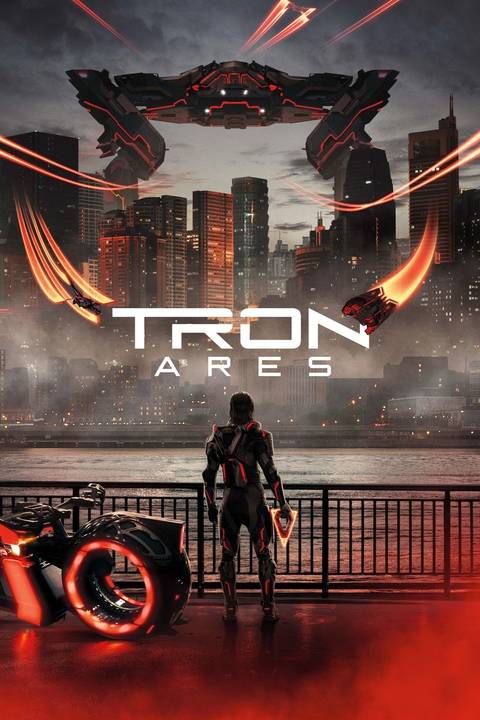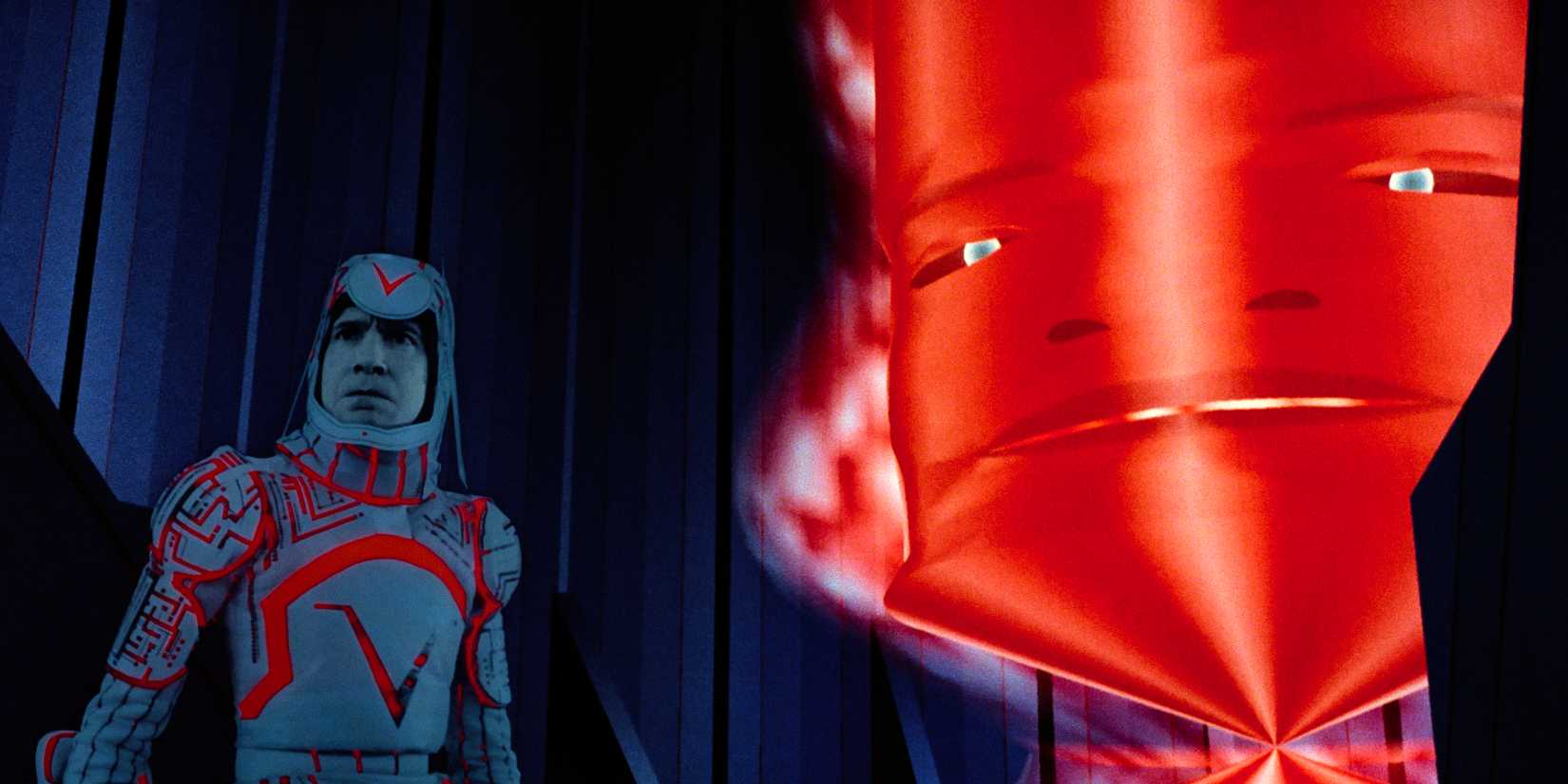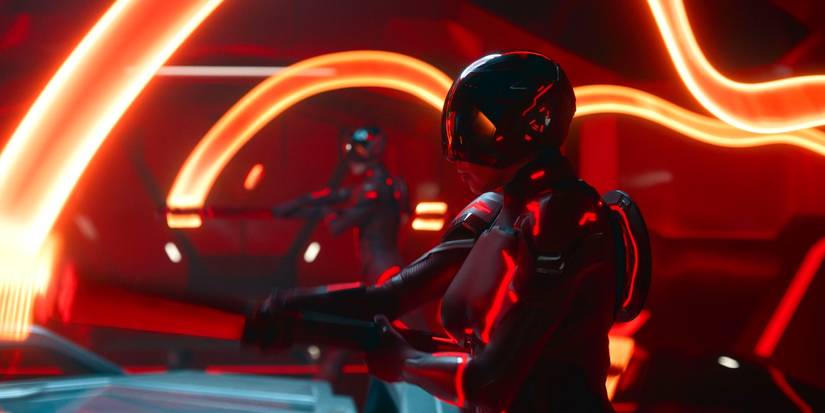Jared Leto and Olivia Wilde teaming up against the ghost of David Warner? That’s the future of the Grid that Tron: Ares posits with its final scenes – even as the future of Tron 4 remains in the balance.
For much of its runtime, Tron: Ares isn’t interested in continuing specific storylines from the previous movie, 2010’s Tron: Legacy. Kevin Flynn (Jeff Bridges) is missing and a version of him is trapped in a computer, but otherwise connectivity is absent: Garrett Hedlund’s Sam Flynn has stepped away from the CEO role he spent a movie building to taking on; Cillian Murphy didn’t reprise his role as explicit sequel-tease Ed Dillinger Jr.; that organic computer life has already crossed over into the real world isn’t explicitly acknowledged.
Warning: Major spoilers from Tron: Ares ahead.
This begins to change in the very final scene. Ares (Jared Leto), now a permanent organic being, is hiding out in Mexico, living as a digital nomad. He’s got a picture of Quorra (Olivia Wilde) and appears to be looking for her.
In Tron: Legacy, Quorra was the last surviving ISO, a form of life Kevin Flynn discovered inside the Grid who escaped with Sam. The only clues given to her whereabouts are in the opening news-dive, where the papers speculate on Sam’s new mystery girl – but it is clear that, if a true Tron 4 happens, the current plan is for it to bring together the two AI beings.
That is a single low-res polygon compared to the bigger reveal in the mid-credits scene. At the climax of the movie, Julian Dillinger (Evan Peters) is cornered by police but, rather than coming in quietly, scans himself into the Dillinger Systems grid.
The credit scene picks up what happens next. With Ares gone, the grid has gone to hell the buildings fractured and futuristic red striping giving way to rolling thunderstorms. Then, out pops a holder for an identity disc, a personal file of a program’s data (that also doubles as a weapon). But this is no ordinary disc; it’s in the style of the painted frisbees from the original Tron and, when Julian grabs it, he begins to transform into a design that’s incredibly familiar to anybody who’s seen the original movie.
That design is the white armor, red-piping and extravagant helmet of Sark, the computer avatar of Ed Dillinger and second-in-command to the villainous Master Control Program in the 1982 Tron. In that movie, Sark was the commander of the Grid forces, hunting down Flynn and Tron with Light Cycles, Light Tanks and Carrier Ships. He was beaten by Tron in a disc battle, before being resurrected as a giant and ultimately derezzed when Flynn destroyed the MCP.
Big Questions About Sark’s Return In Tron: Ares’ Credits Scenes
Dillinger’s importance to Tron can’t be overstated – he’s the primary human antagonist of the original and his progeny are an obsession of the sequels. Bringing back his program has some pretty large ramifications – and raises quite a few questions.
Is this the original Sark, resurrected through his creator’s grandson? The Grid in Tron was on the Encom servers and is presented as distinct from the Dillinger Grid of Tron: Ares. Of course, it’s entirely possible that Dillinger Systems split off from Encom and took elements of the code with it: meaning that the Dillinger Grid is actually an updated version from the original Tron rather than something fresh.
Why has Sark reappeared now? On a franchise narrative level, it’s a result of wanting Tron: Ares to stand away from the previous movies before building towards a more cohesive universe (a tactic that Disney had mixed results with on the Star Wars sequels). In-universe, it could be that the more polished Dillinger Grid needed to be broken down for the underlying program to escape.
Why does Sark still look like the 1982 Grid, rather than the updated version? Tron: Ares crystallized that the complexity of a computer directly influences the visuals of the Grid, with the 1982 Grid (and its recreation in Flynn’s lab) lower-res than those seen in Encom and Dillinger. Sark, however, has the same level of depth as he did four decades ago. This stylistic choice makes clear who we’re seeing – as director Joachim Rønning told Collider, the scene’s purpose was “to honor the franchise somehow, and the original movie”, but it can make sense if this is an older code from the 1980s. This design, also, could change: there’s a history of credit scenes not coming to fruition exactly as they looked, and Evan Peters even said to Collider he didn’t wear the actual costume.
When was this post-credits scene added? Post-credits scenes can sometimes be last minute, or in the case of Marvel movies even come from different directors from in-production movies. For Tron: Ares, this appears to have always been part of the plan. Early trailers showed Peters in the destroyer Grid, meaning it wasn’t a late-day pick-up. It may even suggest this was originally part of the movie proper.
Will Tron 4 Even Happen?
As it stands, Tron 4 is positioned to have Ares teaming up with Quorra and going up against a rebooted Sark. That’s a deep-cut legacy-quel if we ever saw one.
All that is contingent on its box-office performance: so far Tron: Ares has been a damp squib, opening lower than Jared Leto’s infamous Sony/Marvel bomb Morbius (and on a 100% higher budget). Tron has never been a mass appeal franchise, but this certainly feels like a third-time rejection that could put the franchise into sleep mode.
And, even if a Tron 4 does happen in another 20 years, there’s no guarantee that the story will continue. Tron: Ares ditched much of Legacy’s explicit sequel setup, after all.

- Release Date
-
October 10, 2025
- Runtime
-
119 minutes
- Director
-
Joachim Rønning
- Producers
-
Jared Leto, Jeffrey Silver, Sean Bailey, Steven Lisberger, Emma Ludbrook



